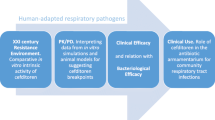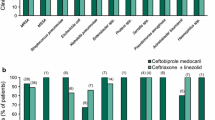Abstract
Cefpodoxime is a oral third generation cephalosporin active against most of gram positive and gram negative bacteria except Pseudomonas, B. fragilis and Entrococcous. Clinical studies have confirmed efficacy of cefpodoxime in acute otitis media, sinusitis and tosillopharyngitis. Twice daily administration and safety profile increases compliance and decreases failure rate. It has a role as switch over therapy from intravenous ceftriaxone in serious respiratory tract infections (RTIs). In areas where common respiratory pathogens show decreased sensitivity to penicillins and macrolides cefpodoxime can be used as empirical first line therapy in respiratory tract infections. It seems to be a promising molecule in pediatric typhoid fever because of its excellent activity against Salmonella species but clinical trials are limited.
Similar content being viewed by others
References
Wise K. β lactams. Cephalosporins. In O’Gradej F, Lambert H, Finch RG, Greenwood D, eds.Antibiotic and Chemotherapy. New York, Churchill Livingstone, 1997; 202–255.
Pichichero ME. Evaluating the need, timing, and best choice of antibiotic therapy for acute otitis media and tonsillopharyngitis infections in children.Pediatr inf Dis J 2000; 19: S131–140.
Frampton JE, Brogden RN. Cefpodoxime Proxetil. A review of its antibacterial avtivity pharmacokinetic properties and therapeutic potential.Drugs 1992; 44: 889–917.
Schatz BS, Karavokiros KT, Taeubel MA, Itokazu GS. Comparison of cefprozil, cefpodoxime proxetil, loracef, cefixime and ceftibuten.Ann Pharmacother 1996; 30: 258–268.
Kumazawa J. Summary of clinical experience with cefpodoxime proxetil in adults in Japan.Drugs 1991; 42: 1–66.
Kearns GL, Abdel-Rahman SM, Jacobs RF, Wells JG, Borin MT. Cefpodoxime pharmacokinetics in children, effect of food.Pediatr Inf Dis J 1998, 17: 799–804.
Rusell W, Steele MD, Thomas MP, Beque RE. Compliance issues related to selection of antibiotic suspensions for children.Pediatr Inf Dis J 2001; 20: 1–5
Bairamis TN, Nikolopoulos TP, Kafetzis DA, Begue P, Lenfant B, Kandiloros DC, Apostolopoulos NJ. Concentration of cefpodoxime in plasma, adenoid and tonsillar tissue after repeated administration of cefpodoxime proxetil in children.J Antimicro Chemothera 1996; 37: 821–824.
Liu P, Muller M, Grant M, Webb AI, Obermann B, Dezendorf H. Interstilial tissue concentration of cefpodoxime.J Antimicrob Chemother 2002; 50: 19–22.
Pichichero ME, Margolis PA. Comparison of cephalosporins and penicillins in treatment of group A beta-hemolytic streptococcal pharyngitis: A meta-analysis supporting the concept of microbial copathogenicity.Pediatr Inf Dis J 1991; 10: 275–281.
Portier H, Chavanet P, Waldner-Combernoux Aet al. Five versus 10 day treatment of streptococcal pharyngitonsillitisia randomized controlled trial comparing cefpodoxime proxetil and phenoxymethyl pecicillin.Scand J Infect Dis 1994; 26: 59–66.
Pichichiero ME, Gooch WM, Rodriguez Wet al. Effective shot course treatment of acute group A beta-haemolytic streptococcalpharyngitis. Ten days of penicillin vs 5 day or 10 day cefpodoxime therapy in children.Arch Pediatr Adolesc Med 1994; 148: 1053–1060.
Block SL. Short course antimicrobial therapy of streptococcal pharyngtis.Clin Pediatr 2003; 42: 663–671.
Cohen R. Clinical efficacy of cefpodoxime in respiratory tract infection.J Antimicrob Chemother 2002; 50: 23–27.
van Dyk JC, Terespolsky SA, Meyer CS, Van Niekerk CH, Klugman KP. Penetration of cefpodoxime into middle ear fluid in pediatric patients with acute otitis media.Pediatr Infect Dis J 1997; 16: 79–81.
Klein M. Multicenter trial of cefpodoxime vs amoxicillinclavulanate in acute lower respiratory tract infections in chilhood.Pediatr Inf Dis J 1995; 14: S 19–22.
V Goelet al. Cefpodoxime: efficacy and safety in the treatment of respiratory tract infections.JAPI 1996; 44: 965–966.
Hendrickson JR, North DS. Pharmacoeconomic benefit of antibiotic step-down therapy: converting patients from intravenous ceftriaxone to oral cefpodoxime proxetil.Ann Pharmacother 1995; 29: 561–565.
Jones RN, Zurenko GE. Prediction of bacterial susceptibility of cefpodoxime by using ceftraixone minimum inhibitory concentration result.Diagn Microbiol Infect Dis 1993; 17: 313–316.
Jankert R, Meer WM. Sequential therapy with intravenous and oral cephalosporins.J Antimicro Chemo 1994; 33: 169–177.
Parry CM. Typhoid fever.Curr Infect Dis Rep 2004; 6: 27–33.
Dhanjee A, Sheikh MA, Yabub M, Alam SE. Orelox (cefpodoxime) in typhoid fever.J Pak Med Assoc 1999; 49: 148–149.
Dyke JW, Angones D, Bhakta D, Tenjaria G, Kumar A. Antimicrobial activity of new antibiotics against bacterial isolates from a community hospital.Chemotherapy 1993; 39: 315–321.
Author information
Authors and Affiliations
Corresponding author
Rights and permissions
About this article
Cite this article
Aggarwal, A., Rath, S. Cefpodoxime — utility in respiratory tract infections and typhoid fever. Indian J Pediatr 71, 413–415 (2004). https://doi.org/10.1007/BF02725629
Issue Date:
DOI: https://doi.org/10.1007/BF02725629




